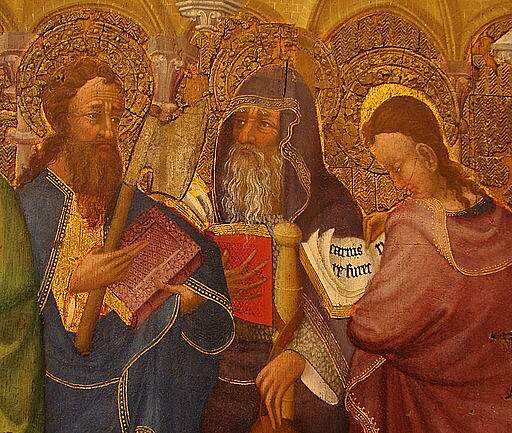
Altarpiece Annunciation (detail), Museum of Laon
Over the past two millennia, the Church has been diving ever deeper into the mystery of Mary - just like we should in our spiritual life. Entering into Mary’s heart means understanding Jesus’ heart and vice versa, thereby finding ourselves at the center of the Church.
Mary’s belief in Christ’s resurrection did not fail her during the darkest hour, while He was lying in the grave and the disciples were dispersed and hiding. She was the remnant of the Church while the flock and its leaders were dispersed. Once Christ rose from the dead, the apostles did not only gather around St. Peter who remained fearful until the descent of the Holy Spirit, but around the blessed Mother who was a pillar of strength.
Living with Mary under a roof must have transformed St. John, though as the contemplative in the group and Jesus’ particularly beloved apostle he already had a good starting-point. His gospel could not have manifested such depth without the blessed Mother’s influence. St. Luke too learned much from Mary as the infancy-description in his gospel shows to the point that he is supposed to have made the first painting of the Virgin Mary.
The successors of the apostles, the early Apostolic Fathers of the Church tried to understand more deeply this mystery of Mary, the new Eve, as did the Church Fathers succeeding them, by pondering what the Apostolic tradition and Scripture were revealing about her.
They only sometimes referred to the apocrypha, the early writings about Christ which were excluded from the Canon. However, some of the apocryphal writings contained some elements of truth as they were drawing on a mixture of tradition and legend. Others unfortunately were vehicles of falsehood like the gnostic apocrypha, diminishing the blessed Virgin’s importance, denying her virginity or her divine Motherhood. They were therefore put to the side and mostly forgotten.
It would take centuries before the first Marian dogmas would be declared. But the early Mariology of the Church Fathers led to Her divine Motherhood being proclaimed in 431 A.D., and her perpetual virginity in 649. More than a millennium passed before her Immaculate Conception would be pronounced in 1854 and then her bodily Assumption into Heaven in 1950. Thanks to the early Fathers, the seeds of these future dogmas were maintained and already reflected upon. The Church moves slowly, but this also allows for a maturing of understanding and a development of doctrine as St. John Henry Newman explained.
In this section, we shall be looking at the development of Mariology during the first centuries by the early Church Fathers as well as presenting some heterodox sources.
Marie Meaney